jQuery Loves Developers - SWDC2009
4 likes1,321 views
Covering jQuery and the details behind the features. Also covers the new 1.3 features.
1 of 192
Downloaded 86 times



















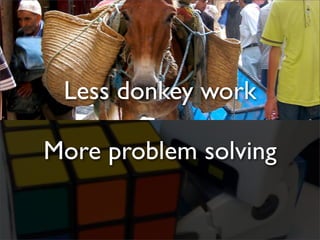




























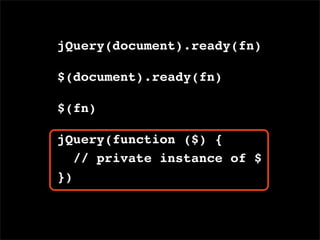




































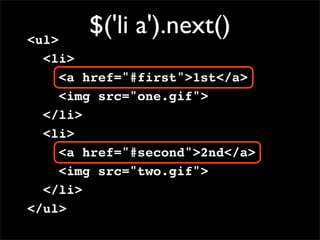
























































































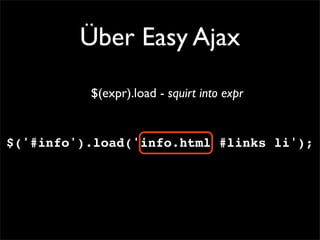











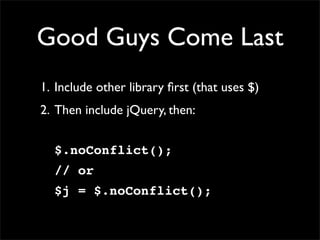





Ad
Recommended
jQuery for beginners



jQuery for beginnersArulmurugan Rajaraman Slides for presentation C002 | jQuery for beginners in Sumofyou Technologies
Jesus de los santos sanchez



Jesus de los santos sanchezperro Los bosques y selvas de México, que cubren el 33% del territorio nacional, son conocidos como "los pulmones de México" porque purifican el aire al convertir el dióxido de carbono en oxígeno a través de la fotosíntesis. Sin embargo, México tiene una de las tasas más altas de deforestación en el mundo, perdiendo un área equivalente a 23 veces el tamaño de la Plaza de la Constitución cada hora. Varias asociaciones como Pro Árbol y CONAFOR trabajan para apoyar los bosques y combatir
Bbbbbbbbbbbbbbbbbbbbbbbbbbbbbb



Bbbbbbbbbbbbbbbbbbbbbbbbbbbbbbharamaya university This document introduces a handbook of biological statistics. It provides an overview of the goals and contents of the handbook, which is designed to teach biology students how to choose and apply appropriate statistical tests to analyze biological experiments. It describes the layout and navigation of the handbook, and how it includes spreadsheets to perform statistical tests as well as instructions for other programs like SAS. It also covers information about citing the handbook and suggestions for further reading on statistics.
FAO - Adaptación de la agricultura al cambio climatico



FAO - Adaptación de la agricultura al cambio climaticoHernani Larrea 1) La adaptación de los sistemas alimentarios al cambio climático es esencial para garantizar la seguridad alimentaria y reducir la pobreza, pero muchos países ya están sufriendo los efectos del cambio climático como sequías e inundaciones. 2) La FAO ha desarrollado herramientas para evaluar los impactos del cambio climático y planificar la adaptación, como metodologías para evaluar los impactos en la agricultura y sistemas de alerta temprana. 3) La FAO también ayuda a los países a integrar la adapt
What Matters Now



What Matters Nowglennmanko "Seth Godin has assembled a crew of five dozen thinkers and doers from around the world. In a remarkable collection of one-page essays, each member of Godin\'s dream team selects a single word-then uses it to offer guidance for the coming year."
HTML5: where flash isn't needed anymore



HTML5: where flash isn't needed anymoreRemy Sharp Flash over the years, has been used to prop up the regular browser like a sad old man drinking alone in a pub.
Today browsers come shipped with technology designed to rival flash and aim to shut it squarely out of the game.
Are browser ready to rock without Flash?
Yearning jQuery



Yearning jQueryRemy Sharp The document discusses a screencast on using jQuery for designers, noting that the screencast will cover getting started with jQuery, DOM navigation and manipulation, events, Ajax, and tips. It provides Remy's contact information and encourages asking questions during the screencast. The document also lists various jQuery resources like documentation, blogs, tutorials, and forums for getting help with jQuery.
Is HTML5 Ready? (workshop)



Is HTML5 Ready? (workshop)Remy Sharp The document discusses the capabilities of HTML5 for building offline applications. It mentions several HTML5 features that enable offline functionality, including application cache, manifest files, and offline events. Application cache allows caching assets defined in a manifest file so the application can work offline. The offline event fires when the browser loses internet connectivity, informing the application it is now offline.
Forget the Web



Forget the WebRemy Sharp This document discusses various web storage options for offline and client-side storage of data, including Web Storage, IndexedDB, Web SQL Databases, and the History API. Web Storage is recommended for simple storage needs due to its wide browser support and easy API. IndexedDB and Web SQL are suggested for larger data storage, with each having some advantages and limitations. The History API can be used to modify browser URLs and handle back button navigation. The offline manifest feature allows creating an application cache to serve local files when offline.
Interaction Implementation



Interaction ImplementationRemy Sharp This document discusses best practices for taking a visual design mockup and implementing it as a functional website. It recommends deconstructing the mockup to understand clickable elements, platforms, and browser support. Estimating costs requires breaking work into components, accounting for risks and unknowns, and tracking time versus quotes. Prototyping early and following a KISS (Keep It Simple, Stupid) approach are also advised. Third-party libraries should be vetted for quality and activity level. The recap stresses function over form, anticipating invisible elements, prototyping, and following a KI(RF)SS (Keep It Relevantly Simple, Stupid) principle.
jQuery: out with the old, in with the new



jQuery: out with the old, in with the newRemy Sharp This document provides an overview and introduction to jQuery. It discusses understanding jQuery and its core functionality as a DOM library. It covers selecting elements, DOM navigation/filtering, debugging selectors, new features like deferreds/promises in jQuery's Ajax functionality. It also discusses best practices like letting the browser handle effects natively when possible, proper use of document ready, and designing well-behaved jQuery plugins.
HTML5: huh, what is it good for?



HTML5: huh, what is it good for?Remy Sharp HTML5 provides new semantic elements like <article> and <header> that allow for more meaningful structure than generic divs and spans. It also enables new multimedia capabilities with <video>, <audio>, and the <canvas> element for drawing. Behind the scenes, HTML5 introduces APIs for offline web applications, local storage, and client-side databases. The document discusses these new features and how to use polyfills to provide fallback support for older browsers that don't yet support the full HTML5 specification.
HTML5 tutorial: canvas, offfline & sockets



HTML5 tutorial: canvas, offfline & socketsRemy Sharp This document provides an overview of HTML5 features including new HTML5 elements, offline capabilities through the App Cache, local storage options, multimedia additions like video and audio, cross-domain messaging, and the Canvas API. It discusses using these features across browsers through polyfills and shims, and emphasizes the importance of JavaScript knowledge for full HTML5 implementation. Web Sockets are introduced as enabling real-time two-way communication through a persistent connection.
Developing for Mobile



Developing for MobileRemy Sharp The document discusses developing for mobile web. It covers several topics including physical properties of mobile devices, their network usage and power constraints. It also discusses different versions of Gmail optimized for different devices. The document recommends inlining content, deferring non-essential work, and being creative with JavaScript libraries and debugging to improve performance for mobile. It highlights the ability of web technologies to build cross-device applications quickly without native restrictions. The conclusion is that native languages may be better if writing many device plugins, but web technologies can be effective otherwise.
Browsers with Wings



Browsers with WingsRemy Sharp HTML5 is all the rage with the cool kids, and although there’s a lot of focus on the new language, there’s plenty for web app developers with new JavaScript APIs both in the HTML5 spec and separated out as their own W3C specifications. This session will take you through demos and code and show off some of the outright crazy bleeding edge demos that are being produced today using the new JavaScript APIs. But it’s not all pie in the sky – plenty is useful today, some even in Internet Explorer!
Webapps without the web



Webapps without the webRemy Sharp We'll look at how the HTML5 and related specifications allow us to develop applications that can survive outside of the web. Browsers now offer us simple storage and more complicated SQL based storage and also full offline support which means we can build our apps to be self sufficient when the user is disconnected. This talk will take you through the technology and walk you though some practical code.
TwitterLib.js



TwitterLib.jsRemy Sharp A walk through of the features of TwitterLib.js - a library that helps standardise all the Twitter API calls and all the data coming back from Twitter, and includes a collection of utility methods to speed development up.
HTML5: friend or foe (to Flash)?



HTML5: friend or foe (to Flash)?Remy Sharp A look at how HTML5 aims to plug the holes that Flash has been filling in browsers for the last decade, looking at both HTML5 and non-HTML5 JavaScript APIs.
For Flash Brighton in Feb 2010.
codebits 2009 HTML5 JS APIs



codebits 2009 HTML5 JS APIsRemy Sharp HTML5 is all the rage with the cool kids, and although there's a lot of focus on the new language, there's lots of interesting new JavaScript APIs both in the HTML5 spec and separated out. This presentation will take you through demos and code and show off some of the outright crazy bleeding edge demos that are being produced today using the new JavaScript APIs.
HTML5 JavaScript APIs



HTML5 JavaScript APIsRemy Sharp HTML5 is all the rage with the cool kids, and although there's a lot of focus on the new language, there's lots of interesting new JavaScript APIs both in the HTML5 spec and separated out. This presentation will take you through demos and code behind the new JavaScript APIs, and explore where these features can be used
iPhone Appleless Apps



iPhone Appleless AppsRemy Sharp This document discusses how to build iPhone apps using only web technologies like HTML5, CSS3, and JavaScript without relying on native iOS frameworks or the App Store. Key points covered include how to create offline-capable apps using the cache manifest, emulate touch events with JavaScript, make the app feel native through CSS transforms and meta tags, and detect device capabilities. The example rubiks cube app demonstrates these techniques to create an offline-capable puzzle game experience on iPhone similar to a native app.
jQuery Loves Developers - Oredev 2009



jQuery Loves Developers - Oredev 2009Remy Sharp jQuery is a JavaScript library which allows you to develop solutions with less code, in less time. You can build interactive prototypes for your prospective clients, or take an existing solution and add new dynamic behaviour with little effort.
We will see how jQuery can be used to quickly and concisely apply JavaScript behaviour to your web app. It will cover selectors, Ajax, DOM manipulation and more. The aim: to produce lean unobtrusive JavaScript with jQuery.
Ad
More Related Content
Viewers also liked (6)
Jesus de los santos sanchez



Jesus de los santos sanchezperro Los bosques y selvas de México, que cubren el 33% del territorio nacional, son conocidos como "los pulmones de México" porque purifican el aire al convertir el dióxido de carbono en oxígeno a través de la fotosíntesis. Sin embargo, México tiene una de las tasas más altas de deforestación en el mundo, perdiendo un área equivalente a 23 veces el tamaño de la Plaza de la Constitución cada hora. Varias asociaciones como Pro Árbol y CONAFOR trabajan para apoyar los bosques y combatir
Bbbbbbbbbbbbbbbbbbbbbbbbbbbbbb



Bbbbbbbbbbbbbbbbbbbbbbbbbbbbbbharamaya university This document introduces a handbook of biological statistics. It provides an overview of the goals and contents of the handbook, which is designed to teach biology students how to choose and apply appropriate statistical tests to analyze biological experiments. It describes the layout and navigation of the handbook, and how it includes spreadsheets to perform statistical tests as well as instructions for other programs like SAS. It also covers information about citing the handbook and suggestions for further reading on statistics.
FAO - Adaptación de la agricultura al cambio climatico



FAO - Adaptación de la agricultura al cambio climaticoHernani Larrea 1) La adaptación de los sistemas alimentarios al cambio climático es esencial para garantizar la seguridad alimentaria y reducir la pobreza, pero muchos países ya están sufriendo los efectos del cambio climático como sequías e inundaciones. 2) La FAO ha desarrollado herramientas para evaluar los impactos del cambio climático y planificar la adaptación, como metodologías para evaluar los impactos en la agricultura y sistemas de alerta temprana. 3) La FAO también ayuda a los países a integrar la adapt
What Matters Now



What Matters Nowglennmanko "Seth Godin has assembled a crew of five dozen thinkers and doers from around the world. In a remarkable collection of one-page essays, each member of Godin\'s dream team selects a single word-then uses it to offer guidance for the coming year."
HTML5: where flash isn't needed anymore



HTML5: where flash isn't needed anymoreRemy Sharp Flash over the years, has been used to prop up the regular browser like a sad old man drinking alone in a pub.
Today browsers come shipped with technology designed to rival flash and aim to shut it squarely out of the game.
Are browser ready to rock without Flash?
More from Remy Sharp (20)
Yearning jQuery



Yearning jQueryRemy Sharp The document discusses a screencast on using jQuery for designers, noting that the screencast will cover getting started with jQuery, DOM navigation and manipulation, events, Ajax, and tips. It provides Remy's contact information and encourages asking questions during the screencast. The document also lists various jQuery resources like documentation, blogs, tutorials, and forums for getting help with jQuery.
Is HTML5 Ready? (workshop)



Is HTML5 Ready? (workshop)Remy Sharp The document discusses the capabilities of HTML5 for building offline applications. It mentions several HTML5 features that enable offline functionality, including application cache, manifest files, and offline events. Application cache allows caching assets defined in a manifest file so the application can work offline. The offline event fires when the browser loses internet connectivity, informing the application it is now offline.
Forget the Web



Forget the WebRemy Sharp This document discusses various web storage options for offline and client-side storage of data, including Web Storage, IndexedDB, Web SQL Databases, and the History API. Web Storage is recommended for simple storage needs due to its wide browser support and easy API. IndexedDB and Web SQL are suggested for larger data storage, with each having some advantages and limitations. The History API can be used to modify browser URLs and handle back button navigation. The offline manifest feature allows creating an application cache to serve local files when offline.
Interaction Implementation



Interaction ImplementationRemy Sharp This document discusses best practices for taking a visual design mockup and implementing it as a functional website. It recommends deconstructing the mockup to understand clickable elements, platforms, and browser support. Estimating costs requires breaking work into components, accounting for risks and unknowns, and tracking time versus quotes. Prototyping early and following a KISS (Keep It Simple, Stupid) approach are also advised. Third-party libraries should be vetted for quality and activity level. The recap stresses function over form, anticipating invisible elements, prototyping, and following a KI(RF)SS (Keep It Relevantly Simple, Stupid) principle.
jQuery: out with the old, in with the new



jQuery: out with the old, in with the newRemy Sharp This document provides an overview and introduction to jQuery. It discusses understanding jQuery and its core functionality as a DOM library. It covers selecting elements, DOM navigation/filtering, debugging selectors, new features like deferreds/promises in jQuery's Ajax functionality. It also discusses best practices like letting the browser handle effects natively when possible, proper use of document ready, and designing well-behaved jQuery plugins.
HTML5: huh, what is it good for?



HTML5: huh, what is it good for?Remy Sharp HTML5 provides new semantic elements like <article> and <header> that allow for more meaningful structure than generic divs and spans. It also enables new multimedia capabilities with <video>, <audio>, and the <canvas> element for drawing. Behind the scenes, HTML5 introduces APIs for offline web applications, local storage, and client-side databases. The document discusses these new features and how to use polyfills to provide fallback support for older browsers that don't yet support the full HTML5 specification.
HTML5 tutorial: canvas, offfline & sockets



HTML5 tutorial: canvas, offfline & socketsRemy Sharp This document provides an overview of HTML5 features including new HTML5 elements, offline capabilities through the App Cache, local storage options, multimedia additions like video and audio, cross-domain messaging, and the Canvas API. It discusses using these features across browsers through polyfills and shims, and emphasizes the importance of JavaScript knowledge for full HTML5 implementation. Web Sockets are introduced as enabling real-time two-way communication through a persistent connection.
Developing for Mobile



Developing for MobileRemy Sharp The document discusses developing for mobile web. It covers several topics including physical properties of mobile devices, their network usage and power constraints. It also discusses different versions of Gmail optimized for different devices. The document recommends inlining content, deferring non-essential work, and being creative with JavaScript libraries and debugging to improve performance for mobile. It highlights the ability of web technologies to build cross-device applications quickly without native restrictions. The conclusion is that native languages may be better if writing many device plugins, but web technologies can be effective otherwise.
Browsers with Wings



Browsers with WingsRemy Sharp HTML5 is all the rage with the cool kids, and although there’s a lot of focus on the new language, there’s plenty for web app developers with new JavaScript APIs both in the HTML5 spec and separated out as their own W3C specifications. This session will take you through demos and code and show off some of the outright crazy bleeding edge demos that are being produced today using the new JavaScript APIs. But it’s not all pie in the sky – plenty is useful today, some even in Internet Explorer!
Webapps without the web



Webapps without the webRemy Sharp We'll look at how the HTML5 and related specifications allow us to develop applications that can survive outside of the web. Browsers now offer us simple storage and more complicated SQL based storage and also full offline support which means we can build our apps to be self sufficient when the user is disconnected. This talk will take you through the technology and walk you though some practical code.
TwitterLib.js



TwitterLib.jsRemy Sharp A walk through of the features of TwitterLib.js - a library that helps standardise all the Twitter API calls and all the data coming back from Twitter, and includes a collection of utility methods to speed development up.
HTML5: friend or foe (to Flash)?



HTML5: friend or foe (to Flash)?Remy Sharp A look at how HTML5 aims to plug the holes that Flash has been filling in browsers for the last decade, looking at both HTML5 and non-HTML5 JavaScript APIs.
For Flash Brighton in Feb 2010.
codebits 2009 HTML5 JS APIs



codebits 2009 HTML5 JS APIsRemy Sharp HTML5 is all the rage with the cool kids, and although there's a lot of focus on the new language, there's lots of interesting new JavaScript APIs both in the HTML5 spec and separated out. This presentation will take you through demos and code and show off some of the outright crazy bleeding edge demos that are being produced today using the new JavaScript APIs.
HTML5 JavaScript APIs



HTML5 JavaScript APIsRemy Sharp HTML5 is all the rage with the cool kids, and although there's a lot of focus on the new language, there's lots of interesting new JavaScript APIs both in the HTML5 spec and separated out. This presentation will take you through demos and code behind the new JavaScript APIs, and explore where these features can be used
iPhone Appleless Apps



iPhone Appleless AppsRemy Sharp This document discusses how to build iPhone apps using only web technologies like HTML5, CSS3, and JavaScript without relying on native iOS frameworks or the App Store. Key points covered include how to create offline-capable apps using the cache manifest, emulate touch events with JavaScript, make the app feel native through CSS transforms and meta tags, and detect device capabilities. The example rubiks cube app demonstrates these techniques to create an offline-capable puzzle game experience on iPhone similar to a native app.
jQuery Loves Developers - Oredev 2009



jQuery Loves Developers - Oredev 2009Remy Sharp jQuery is a JavaScript library which allows you to develop solutions with less code, in less time. You can build interactive prototypes for your prospective clients, or take an existing solution and add new dynamic behaviour with little effort.
We will see how jQuery can be used to quickly and concisely apply JavaScript behaviour to your web app. It will cover selectors, Ajax, DOM manipulation and more. The aim: to produce lean unobtrusive JavaScript with jQuery.
Write Less Do More



Write Less Do MoreRemy Sharp London and Cambridge jQuery DevDays talk introducing jQuery concepts, API overview, live examples and plugin design.
HTML5 & Friends



HTML5 & FriendsRemy Sharp I look at HTML 5, the language the APIs and the big number 2022.
Lots of examples for you check out.
HTML5 JS APIs



HTML5 JS APIsRemy Sharp The document discusses various JavaScript APIs available in HTML5 for building rich web applications, including Canvas, Drag and Drop, Geolocation, Local Storage, Web Sockers, Offline Applications, and more. It provides code examples and links to documentation resources for each API. The last part encourages exploring demos and contacting the author with any other questions.
DOM Scripting Toolkit - jQuery



DOM Scripting Toolkit - jQueryRemy Sharp The document discusses jQuery, a JavaScript library that makes DOM scripting and Ajax requests easier. It provides functions to select elements, handle events, animate elements and load JSON data. Some key features include CSS selector syntax, DOM manipulation methods, event handling and Ajax functions. The document also covers plugins, effects, and utilities included in jQuery.
Ad








